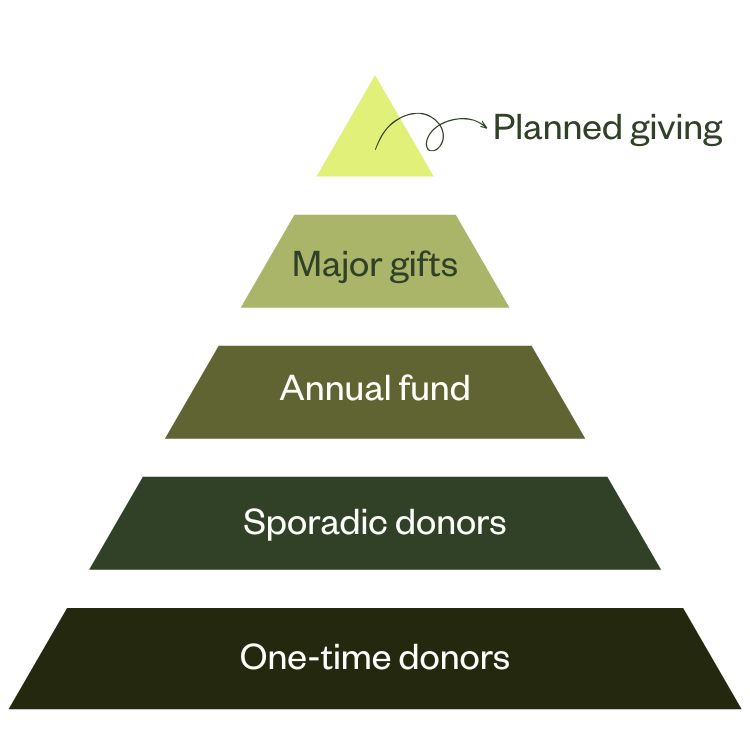
Many nonprofits turn to a tried-and-true tool when laying the foundation for an effective donation strategy: the donor pyramid (AKA fundraising pyramid). The donor pyramid shows you where to focus your attention when fundraising. Have you taken a look at yours recently?
As the fundraising landscape shifts, reexamining your donor pyramid is a necessity. The team at Kindsight is here to show you how the different donation levels can propel new fundraising strategies forward.
What is a donor pyramid?
A donor pyramid is a triangular-shaped visual that organizes the individuals in your current donor base by their donation amount and frequency. There are generally a few individuals who give large gifts at the top and a large number of individuals who give smaller gifts at the base. It is a helpful fundraising tool for keeping your organization on track and ensuring you’re raising the maximum number of gifts.
A donor pyramid or fundraising pyramid can help you identify where you might have gaps (or “opportunities,” as we like to think of them!) in your strategies. It also helps you understand your donor segments better so you can steward each one more effectively.
If your team has put together a donor pyramid, it probably looks like this:

It’s important to keep in mind that every pyramid will look different in terms of how many donors are in each category or segment.
You most likely kicked off your fundraising strategy by crafting a donor pyramid but may not have revisited it for some time. Changes in the general fundraising climate or the world at large may also require a shift in strategy. As an example, where previously you were relying on major donors or planned givers, maybe now it’s time to look for more annual givers.
Be sure to revisit your donor pyramid and conduct prospect research to fill the gaps as you craft new strategies to propel your nonprofit forward in the current year.
How to create a donor pyramid
Complete the following steps to create a donor pyramid from scratch:
- Compile and analyze current giving information from your donor database to group donors into gift sizes (small, mid-size, and major). Your chosen ranges must be specific to your organization. For example, a community playgroup’s gift sizes at each tier will be significantly smaller than those of a research hospital. That’s why it’s essential to begin the process with your organization’s internal donor data.
- Then, perform donor segmentation by grouping the individuals in each of these tiers based on giving frequency, donation amount, and how long they have been donating to your organization. The more specific these groupings are, the more effectively you will be able to steward each type of donor and move similar prospects through the donor funnel.
Updating an existing donor pyramid
An outdated donor pyramid won’t do much to help your cause. Comb through your pyramid and make sure every bit of information is as accurate as possible. This may include deleting any duplicate profiles, taking out lapsed donor information, and ensuring all contact details are current. In the long run, taking the time to verify information will ensure better results!
It’s important to keep in mind that although more accurate information is always better, your donor datasets don’t need to be flawless to yield valuable results. Using a donor research and wealth screening platform can streamline this process further, so you can focus your time and energy elsewhere.
Filling in the gaps
You can complete an imbalanced donor pyramid using prospect research to fill in the gaps. Once you’re ready to dig into your donor pyramid, follow these important steps:
- Look for gaps
With your new pyramid in hand, look for where there may be holes. Taking stock of your current donor pyramid from the start can help you set the best possible fundraising goal for your organization, one that will ensure a lasting impact.
Do you have a lot of one-time donors while annual fund supporters are very low? You may have thought certain programs were performing well, but then you look at your updated donor pyramid and notice there’s a severe imbalance.
To ensure your organization is gaining the support it needs to continue enacting real change within your community, you’ll want to maximize donations at every pyramid level. Lay your current donor pyramid out before you and identify the weaker areas where you have fewer donors than others.
Is monthly membership low or could you use more annual donors? Figure out the areas that could use improvement and then craft a strategy for your development efforts from there.
Tip: While major donors give the largest amounts per donation, recurring donors may have a higher donor lifetime value. Research from Neon One shows that recurring donors stick around for an average of 8.08 years, giving a total of $7,604.17 compared to major donors, who stick around for an average of 1.68 years and give a total of $3,620.67. And don’t forget, donors lower in a pyramid are often where major donors emerge, so nurturing them is very important. Pay just as much attention to the lower tiers of your donor pyramid as the highest tiers for the best long-term ROI!
- Perform targeted donor research
Once you identify areas for improvement, you’re ready to start researching. Perform your prospect research with specifically targeted parameters for the program you want to build out, including factors such as donors’ giving potential, affinity, and philanthropic history.
Cutting-edge prospect research software will allow you to do this with ease. The more factors you’re searching for, the greater chance you have of uncovering the right supporters.
You can also screen your current donors to see who can potentially move up a donor level! For example, the data in your prospect research tool might indicate that some of your sporadic donors have the capacity to give monthly.
- Look for commonalities
Take the time to build out donor profiles for each giving level to see what they all have in common. After you’ve identified these shared characteristics, you can screen for more prospects with those same traits.
Once again, the more specific you are with your searches, the more likely you are to yield the results you’re looking for.
- Refocus and reach out
After you’ve refocused your donor research parameters, you’re ready to find supporters and start crafting your gift asks!
To ensure proper accountability throughout this process, it helps to set clear intentions and assign team roles for using your donor pyramid with prospect research. This might consist of specifying a timeframe, divvying up tasks, and setting a donor prospect goal as well as an overarching fundraising goal.
Building a donation strategy around your donor pyramid
Another way to incorporate the donor pyramid into your fundraising strategy is to build events and fundraisers tailored to different donor levels. After your chosen prospect research tool has helped you build a more well-rounded donor pyramid, it’s time to engage your donors.
It’s important to vary your fundraising strategies to not only appeal to new donors but to further engage current donors. With the increase in virtual events worldwide, it’s now easier than ever to open up your fundraising efforts to mid-level and even lower-level donors.
The following are some events you can plan based on donor pyramid levels:
- One-time donors/sporadic donors
Since these are supporters who only contribute every once in a while, you can expect them to participate in fun, quick events. Some examples of this can be: Online t-shirt and merchandise sales, local business partnerships, online raffles, text-to-give events, etc.
- Members/recurring donors
Members are those who pay a monthly donation fee to receive limited edition merchandise, invites to exclusive events, and access to the latest information first. You’ll want to engage these supporters through member-only fundraisers such as an online auction or with exclusive business partnerships.
- Annual donors
Annual donors are typically major gift donors who support you yearly. Launch an annual fundraising campaign targeted to these givers around the holidays when people are more charitable or around your organization’s anniversary to emphasize all you have accomplished over the past year.
- Major donors/planned giving
These donors have the greatest propensity to support your mission, so it’s important to create a more exclusive event for them. Online galas are a fun and easy way to incorporate these donors. Virtual events are especially helpful since you can reach your supporters no matter how far away they may be located.
As the organizer of a nonprofit, you know no gift is too small. It’s important to incorporate all levels of the donor pyramid in different aspects of your fundraising strategies.
How donor pyramids can assist with capital campaigns
When you have a specific end goal in mind, such as a new hospital wing or afterschool rec center, then you may want to launch a capital campaign. Your donor pyramid can come in handy here as well!
Since capital campaigns are distinguished by two distinct fundraising periods (Private/Quiet and Public) with the majority of gifts being earned in the initial private phase, it’s important you start off strong with your fundraising efforts.
If you aim your fundraising efforts at a random sample of prospective donors, then your return on investment will be diluted. You may be reaching out to people who don’t have the capacity or inclination to support your cause and therefore won’t yield the results you’re looking for.
Using your donor pyramid combined with a custom predictive modeling tool will allow you to find best-match donors. You can then craft specific, personalized asks for donors at different levels using a generative AI tool for nonprofits. This personalization will forge a stronger relationship with donors and help your nonprofit in the long run.
From the donor pyramid to your campaign
When you have clear and concise goal setting with established prospects, you’ll likely have a more successful campaign with minimal roadblocks. The following steps can help you create a data-driven donor pyramid to assist your campaign:
- Uncover the right donors for your campaign. Each campaign is different, and you’ll want to find your supporters based on their individual giving indicators.
- Evaluate your prospects. Choose which ones will be able to contribute to the private portion of fundraising and craft a personalized strategy on how to ask for a major gift.
- Set your budget. Make sure your budget is unique to the resources you’ll need for the specific number of prospects in your campaign. Create a gift range chart (AKA gift pyramid) to see which gift sizes to ask for and how many you will need of each. You’ll also want to build margin into your budget for any unexpected factors or issues that may arise.
- Reach out to your prospects. Go down your list, starting with the largest asks, and continue asking for donations until your list is completed. Even if you meet your campaign goal, continue to fundraise and exceed your original goals. This will set you up for an easier public portion of fundraising and will help cover the expenses of your campaign.
Boost your nonprofit’s revenue with an up-to-date donor pyramid
Donor pyramids are useful tools for visualizing the types of financial supporters that currently make up your donor base, and where gaps exist. While they don’t take into account other kinds of contributions such as volunteering, they are still very helpful for gaining a clear picture of the “puzzle pieces” that make up your nonprofit’s funding.
Using an external donor database with information about prospective donors’ propensity, affinity, and capacity to give is the most effective and efficient way to find individuals to fill out your donor pyramid, and also to identify current donors who could potentially give more.
Contributor:
Bre Alexander
Be the first to read our resources.
The world is changing quickly—and our resources help you stay on top of it all. Sign up to get new insights, success stories, and more, sent right to your inbox.




